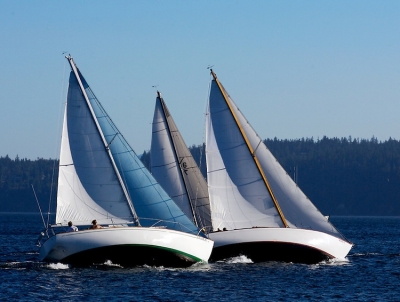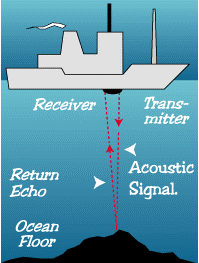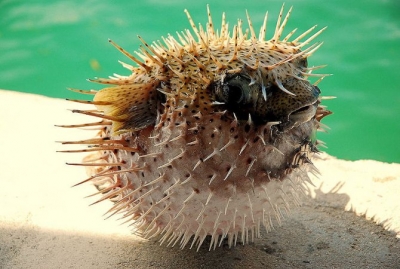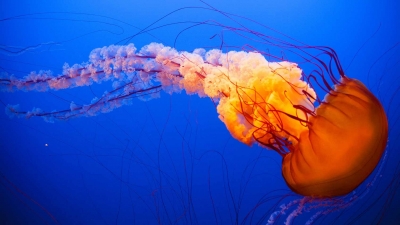
On the bed of the Atlantic, 2½ miles (4km) down, Dr Robert Ballard saw the bulk of the liner Titanic looming in front of him. He and the crew of the miniature submarine Alvin were the first men to set eyes on the ocean giant since she was sunk by an iceberg nearly 75 years earlier. ‘Directly in front of us was an apparently endless slab of black steel rising out of the bottom – the massive hull of the Titanic,’ he wrote.
Of a second dive – one of nine he made in the Alvin during July 1986 – Dr Ballard recalled: ‘Here I was on the bottom of the ocean, peering at recognizable, man-made artefacts designed and built for another world. I was on the bottom of the ocean, peering at recognizable, man-made artefacts designed and built for another world. I was looking through windows out of which people had once looked, [at] decks along which they had walked, rooms where they had slept, joked, made love. It was like landing on the surface of Mars only to find the remains of an ancient civilization similar to our own.’
The Titanic sank about 450 miles (720km) south of Newfoundland, in the early hours of Monday, April 15, 1912. Of the 2200 people on board, only 705 were saved. It was the liner’s maiden voyage.
But it was not until September 1, 1985 – thanks to modern technological aids – that the wreck was located by a joint French-American expedition, headed by Dr Ballard.
The first step in finding a lost wreck – if it is not found by accident – involves meticulous research in historical archives which should establish as accurately as possible where the vessel went down. Sometimes, this can be quite straightforward.
The Mary Rose, King Henry VIII’s flagship, sank in 1545 in relatively calm waters in the Solent – within sight and hearing of hundreds of people ashore, including the king.
As she sail with a fleet of 60 other warships to confront a French invasion fleet, she heeled in the wind and water poured through her starboard gunports. Her cannons broke their moorings and rolled across the decks, adding their weight to the starboard side. The Mary Rose capsized, drowning 650 men. Her position was known, then lost or forgotten. And it was more than 400 years before she could be raised.
The location of ships that went down in sight of land is usually well documented. The Scilly Isles and Britain’s western approaches harbor at least 400 recorded wrecks and hundreds of unrecorded ones. And an estimated $1 billion worth of gold, silver, jewellery and porcelain lie around the coasts of Florida, the West Indies and Central America.
One of the richest finds was a flotilla of ten Spanish treasure ships off Florida. They set sail for home Havana, Cuba, in July 1715, laden with gold, emeralds, pearls and 2300 chests of newly minted coins from Mexico City – treasure worth at least $50 million in modern currency. The ships were caught in a hurricane and went down south of Cape Canaveral.
During the 1950s, local hotelier Kip Wagner, an avid beachcomber, found a few blackened silver coins in Sebastian Inlet, 40 miles (64km) south of Cape Canaveral. Researching their origin, he read about the fleet – and became convinced he had found some of its treasure. He sent a coin to the Smithsonian Institution in Washington, which told him that it could not be from the fleet, because it had sunk 150 miles (240km) farther south.
Undeterred, Wagner and a friend, Dr Kip Kelso, continued their own research and found that Bernard Romans, an English mapmaker, in 1775 had described the place where the fleet went down and had even drawn a map. Armed with a secondhand mine detector, Wagner searched the beaches near the area described – and found a huge hoard of valuables, including a gold chain and pendant, auctioned for $50,000, and a diamond ring worth $20,000.
Wagner put to sea and began to dive up find the wrecks. The treasure he ultimately recovered was worth more than $5 million.
Wagner’s use of a mine detector triggered the use of modern technology in the search for wrecks. In 1970, Rex Cowan, a London solicitor, decided to search for a Dutch East Indiaman, the Hollandia, lost off the Scilly Isles in 1743. He knew from contemporary accounts roughly where the wreck might be, but divers could find no trace. Cowan used a magnetometer – an instrument towed behind a ship which detects anomalies in the magnetic field caused by iron objects such as cannons.
After months of crisscrossing the likely area in a grid pattern, Cowan and his team finally got a reading only a few days before the end of the diving season in September, after which weather conditions tend to be unfavorable. They went below, found nothing, but returned the next day – and discovered cannons bearing the monograph of the Amsterdam chapter of the Dutch East India Company. Next they discovered a silver spoon bearing the crest of a Dutch family, the Imhoff-Bentincks, one of whose members was known to have been aboard the Hollandia, confirming the source. Ultimately, more than 35,000 silver coins, worth around £1 million, were found.
Magnetometers proved unsuccessful, however, in rediscovering the Mary Rose. Although she had sunk only a few hundred yards from the shore, she was covered by mud and sand when the search for the wreck began. A magnetometer found a buried cable not recorded on Admiralty charts – but no wreck.
The breakthrough came from another modern invention – sonar. Developed for underwater warfare, sonar sends out sound signals and records the echoes as they are reflected off solid objects.
A type of sonar called a sub-bottom profiler, which can detect objects embedded in mud or sand, produced signals suggesting the presence of a mound on the seabed – and something solid beneath. Three years later, tides had removed some of the silt from the port side of the wreck and timbers could be seen. Then began the historic recovery and the painstaking recording of its contents – a unique time capsule of life aboard a medieval man-of-war.
But the rediscovery of the Titanic must rank as the most remarkable deep-sea find. It lies too deep for divers and finding it in the immensity of the North Atlantic with only a rough idea of where it lay called for special skill. The joint French-US team used a deep-sea sonar device to search the ocean floor and find the wreck – then a remote-control underwater camera to take the first pictures. A year later, Dr Ballard, a marine geologist from the Woods Hole Oceanographic Institute, Massachusetts, saw the wreck for himself, from the three-man submarine Alvin.
The submarine landed on the bow and the bridge. A remote-control underwater robot camera. Jason Junior, described the Grand Staircase, photographing still-hanging chandeliers, clocks, silverware, and the interiors of staterooms.
With such techniques, few wrecks anywhere beneath the Earth’s oceans are beyond man’s reach. If they are worth investigating mankind now possesses the technology.
Picture Credit : Google







